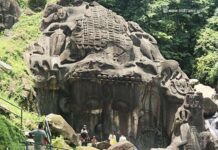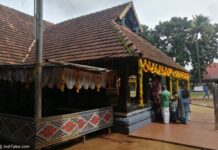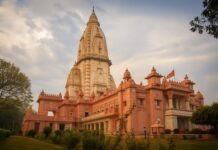Mirabai is the best-known Bhakti poet and Krishna Devotee of medieval times in India. Her devotional songs are sung across India. Most of us know her as the queen of Chittorgarh. Not many of us know that she was the princess of Merta, a small kingdom located between Jaipur and Jodhpur.

From Pushkar, we drove through Aravali Hills, many of which are chipped off for their stone. Some with the temples on the tops of the hills challenged by the steep steps leading to them. The not-so-crowded road made for a pleasant drive on a sunny morning.
History of Merta

Merta is the kingdom of Mertia Rathore Rajputs. Rao Duda, her grandfather is the best-known ruler of this land in the early 16th CE. His fort and palaces can still be seen in some form and shape here. The kingdom changed many hands as battles took between the Rajputs and Sher Shah Suri. By the time she was married into the Sisodia family of Chittorgarh in Mewar, her brother Jaimal was ruling the state. However, he was killed in a battle soon after and the kingdom merged with the kingdom of Jodhpur.
The royal house of Merta takes pride in the fact that they never gave their daughters in marriage to Mughals as many other royal families did. Another exception is the royal family of Mewar, into which she was married.
Mirabai Places to see in Merta
It has some of the best-maintained places to see, unlike many other small towns of this size. There is one main temple and a fort converted into a museum, and both of them are a delight to visit, especially if you are inspired by her.
Charbhuja Mandir

This temple built by Rao Duda, her grandfather is the heart of the town. It is a temple dedicated to the 4-armed avatar of Vishnu. Charbhuja literally means four-armed. The temple complex also houses a small temple dedicated to her bang opposite the main temple.

Legends from the childhood of Mirabai

It is said that Rao Duda dreamed of this Vishnu Murti. He learned that a Mochi or cobbler’s cow has been visiting a certain place and leaving all her milk there. Rao Duda followed the cow and asked his men to dig where it was milking. They found this beautiful Murti of Vishnu. Rao Duda got a grand temple built for it. He used to worship it every day and offered milk to the Murti. The milk came from the cows of the Mochi community. Even today, the milk offered at the temple comes from the same community.

Young Mirabai used to watch her grandfather offer milk to the Charbhuja Murti and as a young girl, she believed that Vishnu drank the milk. Once when her grandfather was away for a few days, she was entrusted with the responsibility to offer milk to the deity. She stood there to watch the deity drink milk. It did not happen, so she went out and watched through the window, but the deity did not move. She started crying and insisting that he drinks milk or else her grandfather would be angry. They say the milk in the bowl went away. The window can still be seen in the temple.
All the stories are painted on the walls of the sanctum of the temple.
Charbhuja Murti

The Charbhuja Murti is about 4 feet high. It is holding the chakra in its lower hand which means that it is the Shanta or peaceful avatar of the deity. When he is ready to kill, chakra would be in his top hands. The priest gave prasad to the visitors while narrating to me the story, everyone wished each other by saying ‘Jai Charbhuja’ and I know this would make it to ‘ 20+ ways to greet in India’.
Pandit Ji also showed me a small Ashtdhatu Murti of Krishna that Mira used to worship. We know that when Mira’s mother told her that her groom was Sri Krishna, she devoted herself to Krishna from that moment as his bride. This was the beginning of her as the saint and poetess we all know.
Meeting Mirabai

The Charbhuja Temple is full of wall murals and glass paintings. As I was walking around, a frail woman in a saffron Sari walked up to me and asked if I was traveling alone. I said, yes and she had all the subsequent questions like why my husband is not accompanying me. We were facing the Mirabai temple and I asked her – Did she not travel all alone across the country, 400 years ago? Are we not her descendants? She and I had a hearty laugh, as she said – you are right. Sometimes the repeated conditioning on our real values needs to go.

To know more read her poetry or her story with Amar Chitra Katha.
I walked around the temple for some time trying to absorb the fact that she grew up playing and praying there.
The temple complex is full of many small shrines including a Shivalinga and a temple to Hinglaj Mata.
Mirabai or Mira Bai Samarak

One room has representations of Mira in different forms of art and literature. Another room showcases places like Dwarka, and Vrindavan that were visited by her. Each place has a story related to her, including her interactions with the people there.

A gallery has illustrated her poetry with some couplets written along. There are tablets in clay depicting her life.

There is a library dedicated to books on her. I could see a part of it, as the other part is not open to the public. Mira Research Institute operates from the same premises. I was not even aware that something like this exists.
A temple dedicated to Nagnechaya Mata – the Kuldevi of the Rathore clan is inside the premises of Mira Samarak or Merta Fort. She is an incarnation of Chakreshwari Devi who was brought here from Kannauj by a Saraswat Brahmin.

It is a lovely memorial cum research center dedicated to the daughter of the land.
Other Things to See

Just outside the gates of the fort, stands a lovely clocktower in white marble.
In the markets, the women were selling colorful lac bangles in primarily yellow and red colors considered auspicious in Rajasthan.
On the side of a lake, I could find the ruins of a palace. Now it is just a ruin standing like a mute spectator, as the city goes on.
You can easily visit this place on a day trip from Ajmer, Pushkar, or Jodhpur.
You need 1-2 hours to see it properly.














Wow, this post was an interesting read Anuradhaji. My native is Ajmer. I will make sure I visit this place during my next visit to Ajmer. Thanks for sharing
लेख बहुत ही शानदार है. यदि आप मीराबाई के जीवन की कुछ तारीखें भी दे देती तो और भी शानदार हो जाता.
Superb. Feel like going there and experience Mira bai’ s bhakti
I have visited Temple hundreds of times but such great.
Thanks for sharing a great post!
Wow, this post was an interesting read Anuradhaji. My native is Ajmer. I will make sure I visit this place during my next visit to Ajmer. Thanks for sharing
You must Darvesh ji, you belong to the land of Mira Bai.
Valuable information. Thanks for sharing.
Hello mam, I am from Merta City and I am really happy to see this blog on Meera bai. I should also visit malkot in merta city